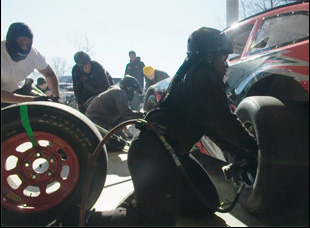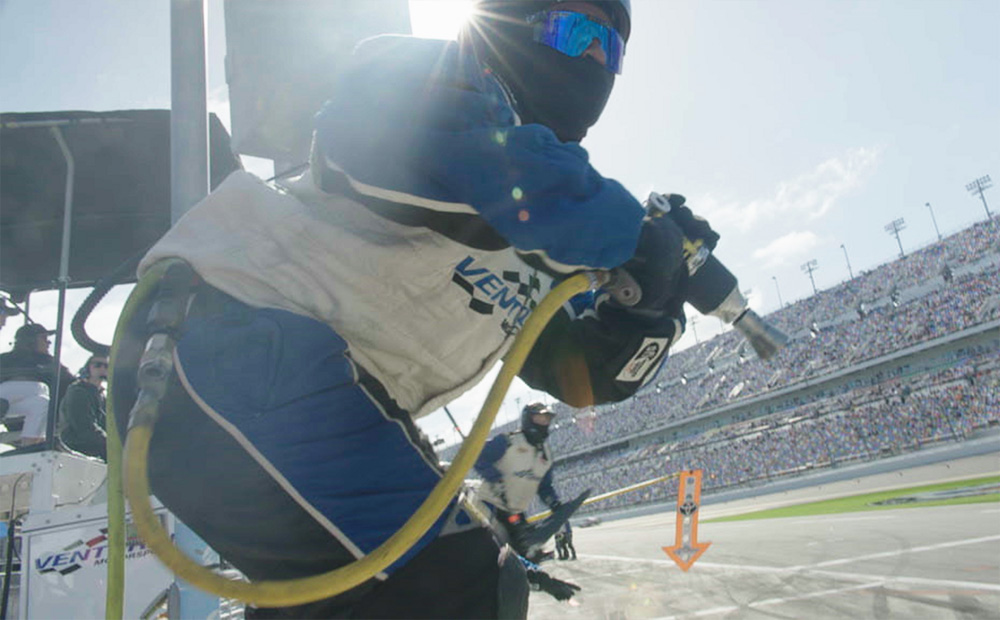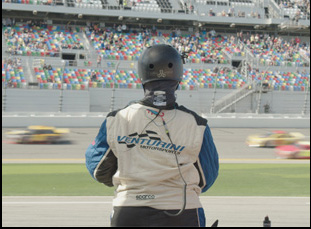There is normally just one athlete associated with any given vehicle in a NASCAR race, but as coach Phil Horton explains in “Over the Wall,” that was outdated thinking that he was brought in as the Director of Athletic Performance at Rev Racing to correct. He was once a personal trainer to a driver, but he saw a way to shave even more time off the clock when as much as one person could do behind the wheel, there were five members of the pit crew that a race could turn on, depending on how fast they could make the necessary adjustments when a car pulled in for a break from the action. Conventional wisdom might call for mechanics who are more concerned for the car’s health than their own, but Horton thought well-conditioned athletes could do the job even better when screwing on a tire was a teachable skill, but natural agility was not. This is how Brehanna Daniels found herself on a track rather than a basketball court after an accomplished collegiate career as a shooting guard, no longer throwing a wrench into another team’s game plan with her fancy footwork, but helping her own team with one in hand.
Still, the track to getting to the Daytona 500 is more circuitous than it might otherwise be for Daniels after injuring herself the May before the February race in Florida, and in “Over the Wall,” director Krystal Tingle sees that as much as attention might be paid to the day of the event, the resolve Daniels has to work herself into shape to compete is every bit as noteworthy, adding to the numerous obstacles she’s already had to overcome to find her place in the pit crew. If it feels intense out in the heat of the race, Tingle crafts the 18-minute-long profile into an adrenaline rush because of how it inspires, showing how all the members of a pit crew come together to put their driver in the best position possible to win while Daniels calls on the strength from various places within herself to play a part in her third Daytona, from turning the same age as her mother was when she developed breast cancer to being a rare Black woman in a predominantly white and male sport.
Daniels isn’t the only one to find her talent in one area is transferrable to another in “Over the Wall” when Tingle, who started out as a producer, presides over a shoot at the biggest race of the year and manages to let the past, present and future of the sport cut across the screen in parallel with one another, mirroring the energy of the subject in the film’s formal rigor. With the short doc making its first stop on the festival circuit at Tribeca, the filmmaker graciously took the time following the film’s premiere to talk about connecting with Daniels, avoiding a traditional doc treatment in favor of something that would honor the pit crew member’s penchant for breaking barriers and the athleticism required to capture the sport as propulsive as it is.
Firelight Media approached me about this series they’re working on, “Sports Explains the World” with Meadowlark Media, and they really wanted to tell sports stories with heart. There were a couple ideas being tossed around, and as soon as I heard Brehanna Daniels’ story about how she made history as the first Black woman pit crew member in NASCAR, I said, any opportunity to feature and center a Black woman that’s doing something in a field that you wouldn’t expect and share that story, I’m going to do it.
What was it like once you got to meet her?
Brehanna is lovely, and it was wonderful getting to know her. We shared a lot of things in common, both of us being black women in fields that are not so diversified. Hollywood and NASCAR are both doing the same thing, trying to expand the field in terms of representation, so we related on that level and also we both had suffered the loss of a parent and it was a very deeply personal loss that impacted the way that we work and the way that we approach our athleticism and our artistry, so we connected on that.
And [with] documentary, it’s all about access, and as a storyteller and a director, it’s my job to gain as much access as I can while respecting and honoring this person’s story and space at the same time, so Brehanna was very generous with her time., but she had a lot of cameras in her face when she made this historic turn in NASCAR several years ago, so we lucked out there because they were used to having a camera crew, but the challenge as we got to know her was getting her to open up and show a side of herself that she never did before, so we could really peel back the layers of who she is, not only as a NASCAR athlete, but as a woman and as someone who has other dreams and aspirations. Se was just a sweetheart and we were so happy to work with her and tell her story.
There’s a scene early in the film where Phil Horton’s talking, and it sounds like so much history is being made. Was it difficult to figure out what to focus on?
Yeah, so much. The core of the story was Brehanna’s injury and just the challenge of it, [whether] she’s going to make it or not to Daytona, but I’m glad you ask about Coach Phil, because they call him the OG of NASCAR and he grew up in the South and he remembers watching legendary NASCAR racers when maybe there was only Black racer there, but he was inspired and knew he could be in this field, so it was really great to have his voice to paint the backdrop of the history of NASCAR, and all the work they’ve been doing at Rev Racing and through the diversity development program to really expand and diversify the field.
It’s such a propulsive film and you resist traditional sit-down interviews for the most part in favor of these stirring voiceovers. What was it like to figure out how the film would move?
In terms of style, I like to stay away as much as I can from a sit-down interview. They can be really beautiful and powerful, and the one moment [in the film] where you saw that was a really just impactful line when we don’t know if [Brehanna’s] going to [make it to Daytona], to build the stakes, but we had such an opportunity to really showcase the artistry and athleticism of what it’s like to be in the pit crew, using that slow-mo footage to see Brehanna move from one side of the car to the other — it really feels like a ballet. It was very operatic, so we wanted to use as much as that footage as we could, and of course, everybody wants to see fast cars driving around a track.
And I had a great conversation early on with my editor Stefani [Saintonge] about the cacophony of the pit crew and how they work together. There was an interview that Curtis [Walls], the trainer in the film, who said to me, “A pit stop is like a symphony. If you close your eyes, you can listen and know whether or not it’s going right.” When he said that, it clicked to me that [we should use] classical or jazz [music] you wouldn’t expect to hear in a NASCAR environment. Maybe some people think that NASCAR can be rock and roll or like a banjo, but I wanted to flip that on its head and offer some jazz because I think the way that the athletes move around in the pit stop, that chaotic kind of orchestration was very similar to how I think a jazz band would perform together. There’s a harmony, but there’s also a discord.

We really knew that we had to be at the Daytona 500, and we went into it thinking that there would be a certain amount of pit stops that we would cover and the drivers have to qualify, so as a pit crew member, you don’t really know who you are pitting with that day, unless you’re on one of these huge cup series teams and they’re paying you gobs of money and like, that’s your crew. But for the other pit crew members, they’re really like freelance contractors, so they get there [on race day] and they say, “Okay, this is your team this day or this week.” And that might change. It’s all based on whether or not their driver actually qualifies. So when we got to Daytona, we had an idea of a certain amount of pit stops that were going to happen and that was really important for me as a director because I needed to know how much footage of this epic pit stop in [Brehanna’s] return we were going to have to work with, so if it was less or more, it would really determine the direction of the climax and figuring out how many pit stops and what that moment was going to look and feel like was a big part of that.
Were there certain images you had in mind for the film? Some of the compositions are really striking, but I know it could be catch-as-catch-can.
Yeah, I’m a writer so I wrote it down on the page first and we really shot this in only four or five days, so one of the biggest challenges visually was how many locations can we shoot in? And how can we diversify this space so that we don’t feel like we’re in the same pit space for the entire duration of the film? I knew we wanted to play with the archive and we had an amazing archival producer Malkia Lydia, who really found some beautiful stuff, just to paint that vintage backdrop of NASCAR and the Americana aesthetic. And I knew I wanted some tender verite moments and the fast cars from Daytona [as well as] quiet moments with Brehanna with no pit crew around. She invited us into her home so we could see her actual life outside of work, so we knew we were gonna be using a lot of those different components and I had amazing editors — and two beautiful black women — Stefani Saintonge and Vashni Korin to put it together.
There’s an enormous amount of athleticism in the camerawork and I know you’ve got an experienced cinematographer in Rex Miller. What was it like to capture?
Rex is amazing. He’s such a great guy and wonderful DP to work with. The great thing was he had filmed at the Daytona 500 previously at another project, so he had that experience of being right there on the wall at the race, knowing kind of what distance we could be at to make sure all our crew was safe. We had safety goggles and even headphones. It was definitely a dance for him and the rest of the crew, getting what you can and working around the pit crew members. We had two cameras shooting at once, so sometimes it was tricky getting around each one, but we were light on our feet and it worked.
What have these been last few days been like for you?
It’s been a whirlwind. My mom came up from Miami, and my nephews and friends and family were flying in from all over, and I’m so grateful to Tribeca for the opportunity to share Brehanna’s story, and I’m grateful to Firelight Media and Meadowlark. It’s been amazing, and also a learning experience, being able to meet with other filmmakers and share new ideas and really just connect. For me, filmmaking is all about the collaboration and community. And it was really cool to have Brehanna here too. Sitting next to her in the theater at the premiere, she hadn’t seen the film [before] and for her to watch herself on camera in a way that she had never seen before was something really special.
“Over the Wall” will screen at Tribeca Festival on June 17th at 6:30 pm at AMC 19th St. East and will be available to stream from June 19th-July 2nd via Tribeca at Home.





